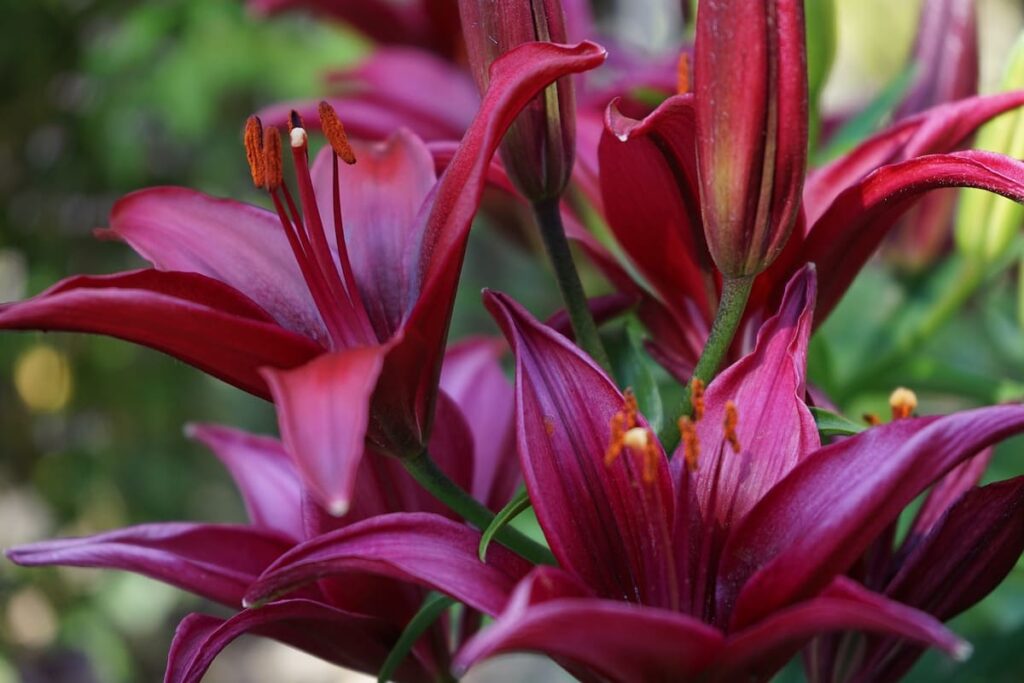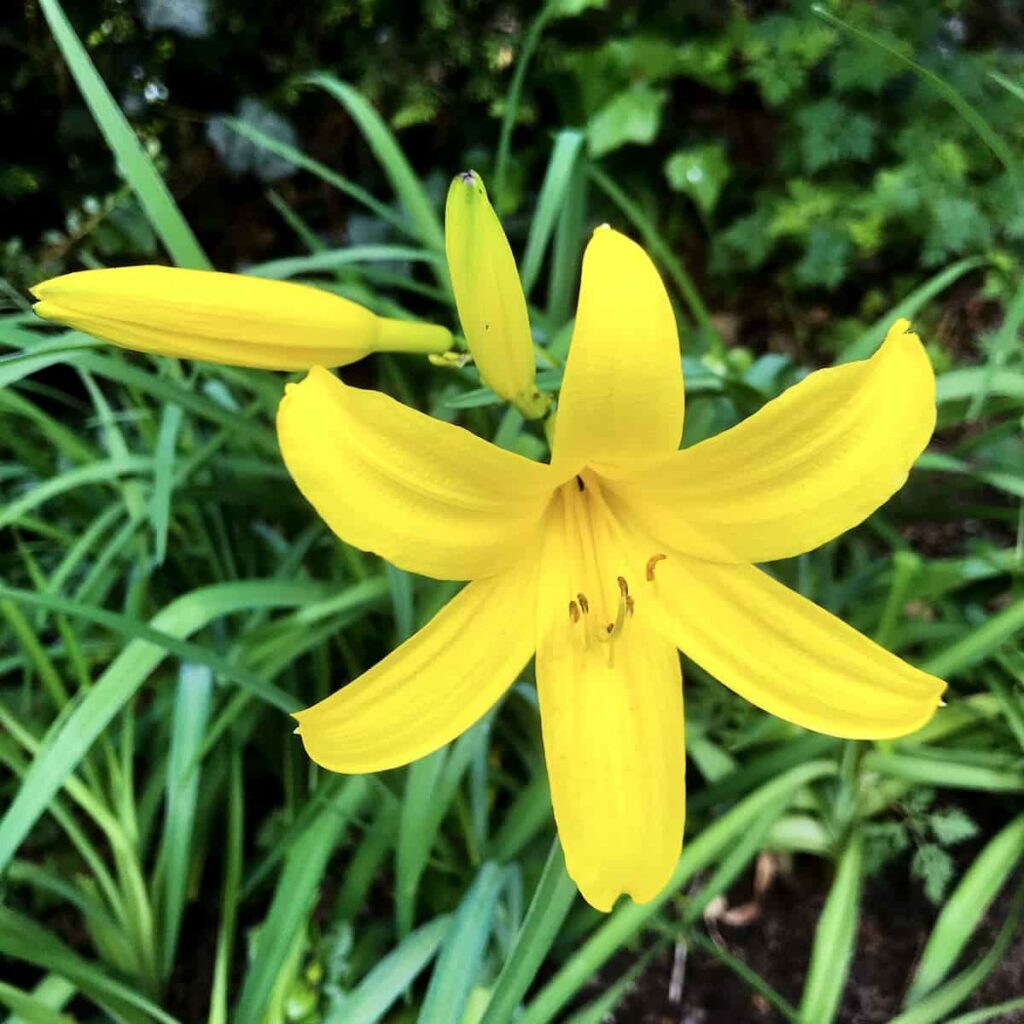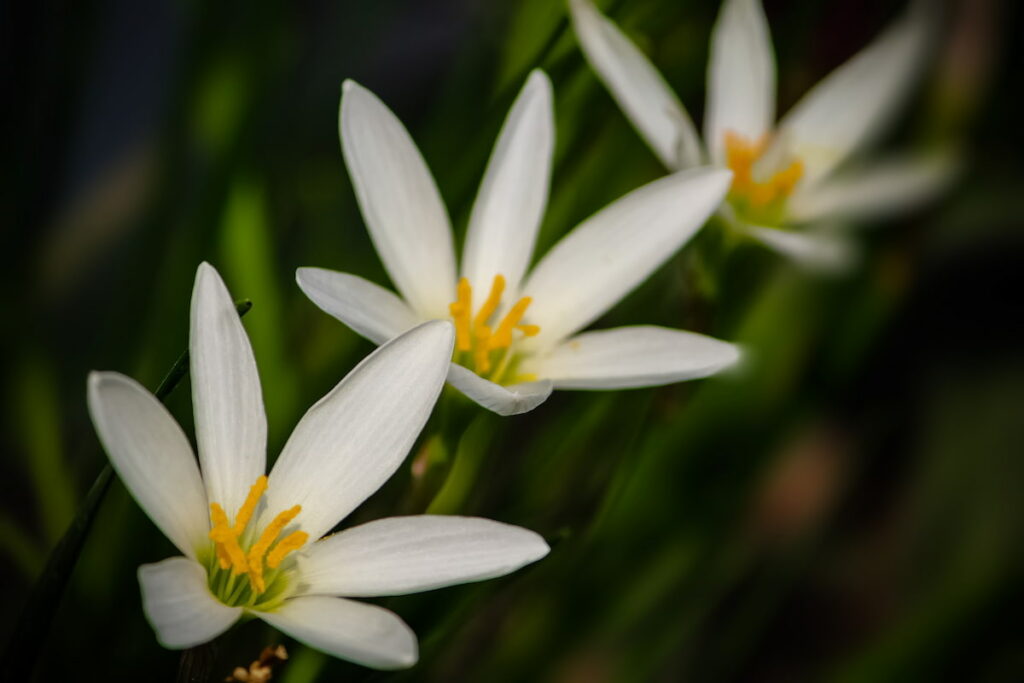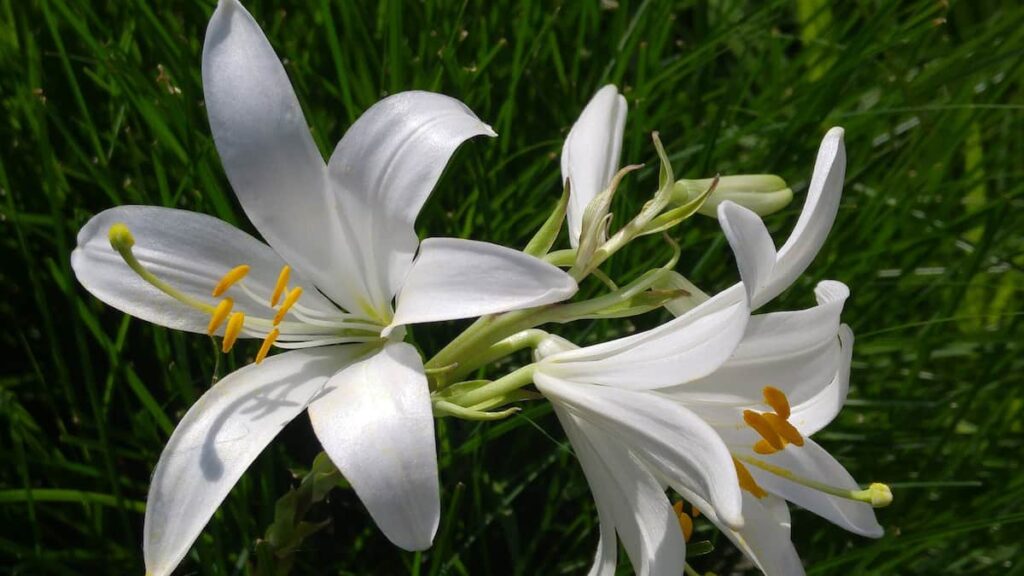Growing Lilies from bulbs is a favorite activity of many gardeners. The Lily flower is a trumpet shape and comes in many colors, including pink, orange, yellow and white. Flower stems range from 2 to 6 feet. There are wide varieties of Lilies, but the general maintenance of Lily plants is essentially the same. You can learn to plant and care for your beautiful Lilies whether you have a large garden or a small indoor pot.

With large, showy blooms, Lily flowers add amazing beauty to every yard and garden. Lilies bloom from early summer to autumn, depending on the variety. But by carefully mixing the early, mid-season, and late varieties in your garden, you can enjoy their blooming spring through the first frost. Growing Lily isn’t as hard as you think and is worth the effort for those who take pride in showy blooms.
How to grow Lilies from bulbs to harvest
How long do Lilies take to grow from the bulb?
- Lilies are produced from bulbs that multiply every two or three years. Some varieties grow more slowly than others and may not require division like other types of bulbs. Most Lilies are hardy perennials that can survive in the winter and come back year after year. Plant them once and enjoy their magnificent flowers for many years to come.
- Different types of Lilies bloom during a certain range of time. Most Asiatic Lilies bloom 30 to 45 days after growth begins. Orientals take 40 to 90 days to bloom. Smaller offsets can take 2 to 4 years to flower, but larger ones can bloom in 1 to 2 years. Bulblets will be identical in parent plant type, making it a viable method for both hybrid cultivars and species of plants.
How many Lilies do you get from one bulb?
One of the best things about a perennial garden is how the flowers multiply over time. As the bulbs get bigger and more mature, the Lilies spread. Lilies also multiply by forming small bulblets on the mother’s bulb or bulbils on stem or leaf axils. Mature Lily bulbs can produce up to 12 flowers per stem and multiply to form clumps over the years.
In case you missed it: How to Grow Peach From Seed to Harvest: Check How this Guide Helps Beginners

Sun requirement for growing Lilies from the bulb
- In a dry climate, mulching the soil surface will reduce moisture loss and keep the soil cool. Lily bulbs grow best when they get full sun or at least half a day’s sun. In a warm climate, they appreciate being shaded by afternoon heat. While Lilies look like they’d be annoying plants, they’re much easier to grow. They are not particular about soil type or pH.
What to do with a Lily bulb after it blooms?
- After blooming, you can also remove the stem. However, please do not remove the leaves until they die and turn brown in the fall. It’s very important not to cut the leaves back until the end of their season because they help provide the bulb nutrition for the next season’s planting.
- Cut out the spent flowers and allow the greenery to die back. Reduce the water when the plant starts to go dormant. Once all the leaves die back, dig out the bulbs and separate anyone divided into offsets. Offsets are new bulbs and will result in new plants.
- Let the bulb dry in a cool, dark place for a few days. Many gardeners dust the bulbs with fungicides before storing them, but this is unnecessary if there is no sign of rotting and the bulbs have dried completely. Place the bulb in peat moss inside a cardboard box or paper bag.
Soaking Lily bulbs before planting
- Lilies should be stored below 8°C, they will probably sprout before planting. If they do, treat the sprouts gingerly. If you break them, your bulbs won’t bloom. Dahlias and Gladiolus can stand at slightly higher temperatures. It would help if you soaked your bulbs before planting. Lily bulbs don’t have the same protective coating as many flower bulbs, so they can dry quickly. For this reason, it is wise to soak your bulb for 2 hours before planting.
- If the bulbs are dry or soft, soak them for an hour or two before planting. It can help your bulbs root into the ground. Lily bulbs are corms, and a real bulb does not have a protective coating. This allows them to dry more easily than bulbs like Tulips and Daffodils.
In case you missed it: How to Grow Pears from Seed to Harvest: Check How this Guide Helps Beginners

Should I cut Lilies down after flowering?
- The Lily flowers should be removed as soon as they fade. Blooms left in place will produce seeds, which diverts energy from flower production and plant growth. Flowers can be cut or pinched off. Alternatively, cut the stalks when they bloom and use them in floral arrangements.
- Deadheading Lilies will encourage more flowers to be formed. Deadheading diverts energy away from seed production, reducing flowering performance later. Lilies are like Tulips and Daffodils because they need leaves to build nutrients for next-season flowers. There is no harm in cutting individual flowers. If you cut any Lily, take no more than 1/2 to 2/3 of the stem (leaves), or they won’t be able to rebuild themselves to bloom next summer.
Water requirement for growing Lilies from the bulb
- Lily usually doesn’t need much water, so only water if needed. Asiatic, Trumpet and Orienpet Lilies thrive in warm, dry climates if they have enough water for flowering. Orientals need water during the summer, as they don’t bloom until August. Place a line of soil about 1 inch under the edge of the pot to water. You should water only when the top layer of soil looks dry.
- During active growth, water freely, especially if rainfall is less than 1 inch per week. Keep the Lilies mulched so that their roots are cool. Providing 1 inch of water per week when plants are actively growing. Water should only be provided if the soil feels dry below the surface, as very wet soil can rot the bulb. Avoid planting Lilies in areas where there is often standing water. If rain is not enough, extra water is recommended.
What happens if you don’t plant Lily bulbs deep enough?
- If the Lily bulbs aren’t planted deep enough to create underground roots between the top of the bulb and the surface of the soil, the bulb will have difficulty picking up enough nutrients to survive. Encouraging the formation of stem roots after planting should be your most important, immediate goal.
- Proper planting depth and spacing are most important for the health and vitality of flower bulbs, especially those for perennials. Too shallow to plant flower bulbs can expose them to harmful temperature spiking. Dig a generous planting hole 8 inches deep. Put some all-purpose compost at the bottom of the hole and mix it. Add a handful of loose soil to the hole, then position the bulbs 6 to 10 inches deep.
In case you missed it: How to Propagate Aloe Vera: Without Roots, Leaves, Cuttings on the Ground and in the Water

Growing Lilies in pots
- Lilies grow well in containers, where they can be positioned in the garden for maximum effect. This is a great way to grow these magnificent plants, especially if you can’t grow them in your garden. Bulbs should be planted deep enough, so choose a large pot and fill it with good quality, peat-free multipurpose compost. Place them on the surface, their roots on the compost, and their growing tips upwards.
- On heavy, clay soil, the best way to grow Lilies is in pots, decorative containers, or black plastic ones that you can leave in borders where you want different flowers. You can plant the bulb in loam-based compost mixed with grit, two-thirds of the compost with one-third grit.
- The pots for Lilies must be at least 15 to 18 inches deep for maximum bulb root growth. The bulb should be planted at least 8 to 12 inches deep, plus there should be at least 6 inches of soil under the bulb. You can grow three bulbs in a large and deep 5-gallon pot.
Fertilizer requirement for growing Lilies from the bulb
- Organic fish fertilizer is the perfect nutritional source for growing Lilies. You should place Mulch with several inches of organic compost, or shredded bark keeps the soil cool and moist. Lilies love to feed while they grow. Ideally, give them a top dressing every two weeks with liquid potash feed and slow-release fertilizer.
- Apply a high potassium liquid fertilizer every two weeks from planting to 6 weeks of flowering. Lilies are quite hardy and don’t require too much fertilizer. Too much nitrogen can result in weaker stems and bulb rot, even in warm, wet climates. For maximum results, choose a high-potassium liquid fertilizer. Continue feeding Lilies after the flowers are finished to help the bulbs grow and ensure a good display next year.
When to plant Lily bulbs
You can plant Lily bulbs in autumn or early spring. If planting in the fall is important, it is necessary to do so at least four weeks before your last frost date so that they can put down strong roots before the ground freezes. You can plant in early spring when the ground is viable but not muddy. Bulbs will produce more mature roots in early and mid-spring before they begin to produce stalks and leaves.
In case you missed it: How to Get Rid of Bugs on Indoor Plants: Simple Tips, Ideas, and Techniques

Soil requirement for growing Lilies from the bulb
- Lilies work best in partially sandy soil. The potting mixtures, mostly peat, will remain very wet and cause bulbs to rot. However, you can use any potting mix and only add sand to it. Mix about two parts potting mix with 1 part sand.
- Lilies work best in full sun position, ideally rich and with their roots in enough moist yet free-drained soil or compost. Grow Oriental Lilies in acidic or ericaceous compost and Asiatic Lilies in neutral to alkaline soil or multipurpose compost. Like most bulbs, Lily won’t tolerate soggy soil. In addition, any good garden soil is fine. You can mix some shredded leaves or other organic matter at planting to encourage strong root growth and help keep the soil lightly moist.
What month do Lilies bloom?
As with most bulbs, Lilies bloom only once per year. They need a cold winter dormancy period of at least eight weeks to reinitiate the flower cycle. Each plant blooms in 2 to 3 weeks of the year. Most bulbs bloom after 5 to 8 weeks of coming out of the cold, heralding spring with bright colors and sweet fragrances. The blooming duration varies with the bulb type and variety.
Planting Lily bulb
Plant them pointy end up, and don’t worry if the bulbs burst. Plant them with the sprout just above the ground; even if it’s bent, it will right itself in three to four weeks. Once brought out of cold treatment and placed in a cool, sunny window, the bulb should flower in three to four weeks. Closer to spring, they flower faster than in high temperatures. After the shoots and leaves have expanded, move your bulb’s direct sunlight to a warm place.
Winter care of Lilies
- If you live where there is no freezing, you can leave the bulbs in the ground all year round. Gardeners in cold climates will do well to pull up the bulbs and save them indoors unless you treat the plants as annuals.
- To store the bulbs, pack in milled peat moss, perlite, shredded paper, or sterilized dry compost. Or store them in mesh bags, hang them or put them in boxes for the winter. Add several sheets of paper between layers of the bulb to help absorb moisture and reduce the chances of rotting. In winter, Lilies will survive outdoors in mild climates that do not experience more persistent snow, deep freezing, or heavier long rains in the colder months.
In case you missed it: How to Build Trellis for Gourds: A Step-by-Step Planting Guide for Beginners

How do you harvest your Lily flowers?
- Cut the Lilies for arrangements when the buds are on the verge of opening, preferably early in the morning. Immediately immerse the stems in cold water. Cut them with scissors or pruning shears as the flowers fade in the garden.
- Lilies bloom no more than once every season, but you can remove faded flowers, so plants don’t waste energy making seeds. After blooming, you can also remove the stem. However, please do not remove the leaves until they die and turn brown in the fall.
- Once the flower fades, pluck it with your fingers or cut it with a pair of scissors to stop the seedpod’s production. However, make sure not to remove any leaves from the flower.
Conclusion
There are wide varieties of Lilies with flowers in various beautiful colors, including white, yellow, orange, pink, and red, as well as many colorful lines, dots, and stripes that add even more to the beautiful flowers. There are many popular species, and their endless hybrids are available to gardeners. Growing Lilies in the garden is the best way to make amazingly beautiful bouquets. And for all this, you must familiarize yourself with their needs, such as soil, location, and others.
- Gardening Techniques in Planting Vegetables
- Where to Place Indoor Plants in Your Home
- How to Grow Tomatoes Organically at Home: A Comprehensive Guide
- Organic Gardening on a Budget: Low-Cost Methods and Materials
- Gongura Seed Germination and Planting Methods
- Cabbage Seed Germination and Selection
- Broccoli Seed Germination and Selection
- Asparagus Seed Germination and Variety Selection
- Seasonal Flower Gardening: Best Practices for Spring, Summer, Fall, and Winter
- How to Grow Hibiscus from Flower
- Plantation Ideas for Home Decoration: A Beginners Guide
- Flower Garden Designs and Layouts for Beginners
- Planting and Spacing Techniques in Papaya: A Beginner’s Guide
- Growing Gold: Essential Techniques for Planting Pineapples
- How to Make Kalanchoe Plant Bushy: Home Remedies and Solutions
- 11 Reasons Why Your Gardenia is Not Blooming: Home Remedies and Solutions
- Eco Elegance: The Guide to Designing a Drought-Tolerant Landscape
- Gardening on a Slope: Strategies for Hillside Landscaping
- Nourish and Flourish: Top Organic Mulches for Thriving House Plants
- Everything You Want to Know about Indian Mogra Flower: Discover Uses and Growing
- Green Thumb Success: Expert Tips for Cultivating Greenhouse Pumpkins All Year Round
- Maximize Growth & Flavor: The Ultimate Guide to Companion Planting in Herb Gardens
- How to Control Rhododendron Problems Naturally: Home Remedies and Organic Ways to Fix Them
- Natural Magic: The Remarkable Benefits of Cinnamon for Plants
- Best Steps to Revive Dying Tulip with Natural and Organic Treatment
- 10 Reasons Why Your Angel Trumpet is Not Blooming: Remedies and Treatment
- How to Fix Periwinkle Leaf and Flower-Related Problems: Natural Remedies and Solutions
- How to Fix Zinnias Leaf and Flower Problems: Discover Natural and Home Remedies
- Organic Steps to Induce Lemon Tree Flowers: A Comprehensive Guide
- Bloom Booster: Crafting the Perfect Homemade Bougainvillea Fertilizer
- Optimizing Growth: A Guide to Applying NPK Fertilizer for Potted Plants
- 10 Best Homemade Fertilizers for Rubber Plant: DIY Recipes and Application Method
- How to Boost Female Pumpkin Flowers: Effective Steps for More Flowers and High Yields
- Transform Your Indoor Garden: Top Benefits of Pink Salt for Houseplants
- 10 Best Homemade Fertilizers for Peacock Plants (Calathea): Easy DIY Guide
- Unlock Blooms: 9 Reasons Why Your Potted Chrysanthemum is Not Blooming